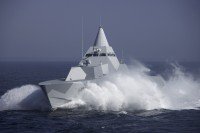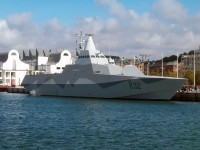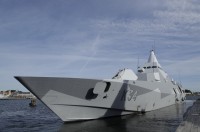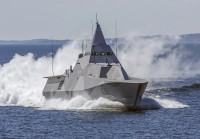Корветы типа «Висбю»
Основная информация
Главные размерения
Машина
- 2 * 125SII Kamewa Waterjets
- 4 * Vericor TF50A gas turbines, total rating 16 MW
- 2 * MTU Friedrichshafen 16 V 2000 N90 diesel engines, total rating 2.6 MW
- 3 * generators of 270kW each
Персонал
Боевые силы и средства
- Kockums GHOST Fiber Reinforced Plastic (FRP)Hull
- Saab 9LV combat management system
- Saab Sea GIRAFFE AMB 3D PESA surveillance radar
- Saab Ceros 200 stealth fire control radar system
- Condor CS-3701 tactical radar surveillance system
- GDC Hull-mounted sonar
- Hydroscience Technologies towed array sonar system
- GDC variable depth sonar
- Rheinmetall TKWA/MASS (Multi Ammunition Softkill System)
- 1 * Bofors 57 mm Mk3
- 8 * RBS15 Mk2 anti-ship missiles
- 4 * 400 mm torpedo launchers for Torped 45 torpedoes
- ASW 127mm rocket-powered gernade lauchers
- Mines & depth charges
- Provision for but not fitted with
- 2 * 6 127 mm ALECTO anti-submarine rocket launchers (cancelled)
- 12 * Umkhonto SAM (cancelled)
The Visby class is the latest class of corvette to be adopted by the Swedish Navy after the Göteborg and Stockholm-class corvettes. The ship's design heavily emphasizes low visibility, radar cross-section and infrared signature. The first ship in the class is named after Visby, the main city on the island of Gotland. The class has received widespread international attention because of its capabilities as a stealth ship.
The ships are designed by Swedish Defence Materiel Administration (FMV) and built by Kockums AB. The first ship of the class was launched in 2000 and since then the construction was fraught with repeated delays. Finally in December 2009, the first two ships of the class were delivered to the Swedish Navy by the FMV, albeit with greatly reduced operational capability.
The hull is constructed with a sandwich design consisting of a PVC core with a carbon fibre and vinyl laminate[4] (see also the Oceanic-Creations spin-off). There are multiple advantages to using composite materials in ship hulls. Good conductivity and surface flatness means a low radar signature, while good heat insulation lowers the infrared signature and increases survivability in case of fire. The composite sandwich used is also non-magnetic, which lowers the magnetic signature. Composites are also very strong for their relative weight, and less weight means a higher top speed and better maneuverability. The composite weighs roughly 50% less than the equivalent strength steel.
Visby's angular tumblehome design reduces its radar signature. Jan Nilsson, one of the designers, told BBC News Online: «We are able to reduce the radar cross section by 99%. That doesn't mean it's 99% invisible, it means that we have reduced its detection range.» The 57 mm cannon barrel can be folded into the turret to reduce its cross section. There are plans for additional improvements in this area, especially for the deck rails and masts.
Much of the design was based on the experiences learned from the experimental ship HSwMS Smyge. The class was originally designed to be divided into two subcategories where the last ship were optimized for surface combat and 4 others for submarine hunting; however, this was changed due to cutbacks.
A helicopter, such as the Agusta Westland A109M selected by Sweden, can land, take off, and refuel on the upper deck. A helicopter hangar was originally planned but was considered to be too cramped and was removed.
The ships took an exceptionally long time from launch to delivery and the construction has been fraught with repeated delays. In 2008, the only weapons system that had been integrated and tested in Visby was the gun.
Finally, on 16 December 2009, the first two of the corvettes were delivered to the Swedish Navy by the Försvarets materielverk (FMV). The two ships, K32 and K33, were delivered with underwater and surface/air sensors fully integrated. However, the only weapon that had been integrated and test fired on the ships was still the Bofors 57 Mk3 gun. The FMV calls this version 4, which aims to get the ships into service and start training crews.
Version 5 is due in 2012, and is intended to supplement the ships with mine clearance systems, helicopter landing capability (only K31 is certified to date), anti-surface ship missiles and additional stealth adaptation. Visby was the first of the corvettes to be upgraded to Version 5. On 22 March 2012 FMV reported that the ship had been modified and that the system would be tested before reentering the Swedish Navy by the end of 2012.
Although the design of the ships originally called for the installation of surface-to-air missiles, on 18 September 2008 the Genomförandegruppen cancelled the project in order to rationalize the procurement of defence materiel for the Swedish defence.
Корабли5
- Комментарии
 ru
ru en
en uk
uk
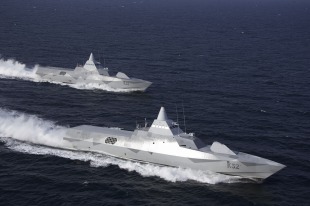



 Военно-морские силы Швеции
Военно-морские силы Швеции Kockums Naval Solutions
Kockums Naval Solutions